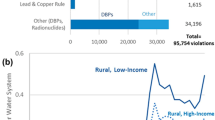Abstract
Following a natural disaster, access to safe drinking water by the affected population is a high priority. Low cost water purification systems, which can be used for both short-term (immediate) and long-term (sustainable) response to serve the needs of the affected communities, are ideal for these scenarios. The University of Hawaii has developed three low cost water purification technologies for use during humanitarian assistance and disaster relief (HA/DR) missions. A UH team participated in joint USA and partner nation training exercises, such as Crimson Viper 2010 and 2011, organized by the Marine Corps Forces Pacific Experimentation Center (MEC) in Sattahip, Thailand, to demonstrate the effectiveness of these technologies to purify water from local sources. Three technologies were selected for Crimson Viper 2010: (1) a backpack filter unit, (2) a bicycle pump powered reverse osmosis (RO) unit, and (3) a model slow sand filtration unit. For Crimson Viper 2011, improved versions of the backpack and RO units were deployed. This article discusses and evaluates the results obtained during the demonstration of the three technologies at these exercises.










Similar content being viewed by others
Abbreviations
- APIX:
-
Asia Pacific Information Exchange
- DSTD:
-
Defense Science Technology Division
- DR:
-
Disaster relief
- FHA:
-
Foreign humanitarian assistance
- HA:
-
Humanitarian assistance
- HTDV:
-
Hawaii Technology Development Venture
- LED:
-
Light emitting diode
- MEC:
-
Marine Corps Forces Pacific Experimentation Center
- NADESCOM:
-
National Development Support Command
- ONR:
-
Office of Naval Research
- PFC:
-
Perfluorochemicals
- PICHTR:
-
Pacific International Center for High Technology Research
- RO:
-
Reverse osmosis
- UH:
-
University of Hawaii
- USPACOM:
-
United States Pacific Command
- UV:
-
UltraViolet
References
Bellamy WD, Silverman GP, Hendricks DW, Logsdon GS (1985) Removing giardia cysts with slow sand filtration. J Am Water Works Assoc 77(2):52–60
Boyle PM, Houchens BC (2008) Hands-on water purification experiments using the adaptive WaTER Laboratory for Undergraduate Education and K-12 Outreach. In: Proceedings of the 2008 ASME Fluids Engineering Division Summer Meeting, Jacksonville, FL, pp 107–116
Haarhoff J, Cleasby JL (1991) Biological and physical mechanisms in slow sand filtration. American Society of Civil Engineers, New York, pp 19–68
Huisman L, Wood WE (1974) Slow sand filtration. World Health Organization, Geneva. ISBN 9241540370
Logsdon GS, Kohne R, Abel S, LaBonde S (2002) Slow sand filtration for small water systems. J Environ Eng Sci 1:339–348
Oasis Design (1991) Slow sand filtration. http://www.oasisdesign.net/water/treatment/slowsandfilter.htm
Olsen P, Paulson D (2008) Water science and marketing, LLC, performance evaluation: removal of perfluorochemicals with point-of-use water treatment devices, final report prepared for the state of Minnesota, Minnesota Department of Health
Acknowledgments
Funding for this research was provided by Pacific International Center for High Technology Research (PICHTR)/Hawaii Technology Development Venture (HTDV) through the Office of Naval Research (ONR). The authors would like to acknowledge the United States Pacific Command (USPACOM) and the Marine Corps Forces Pacific Experimentation Center (MEC) for their support for this project.
Author information
Authors and Affiliations
Corresponding author
Rights and permissions
About this article
Cite this article
Ray, C., Babbar, A., Yoneyama, B. et al. Evaluation of low cost water purification systems for humanitarian assistance and disaster relief (HA/DR). Clean Techn Environ Policy 15, 345–357 (2013). https://doi.org/10.1007/s10098-012-0530-1
Received:
Accepted:
Published:
Issue Date:
DOI: https://doi.org/10.1007/s10098-012-0530-1




